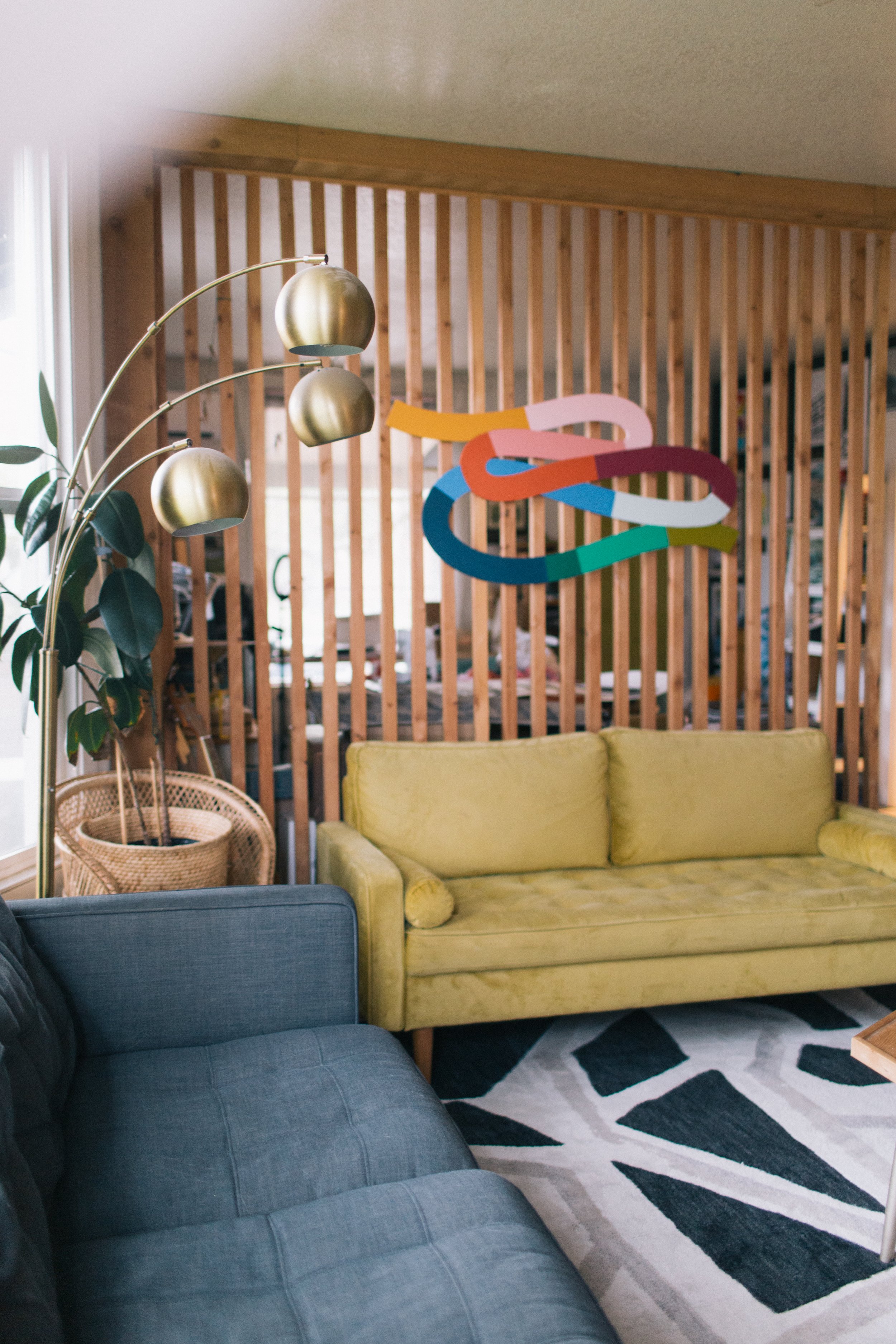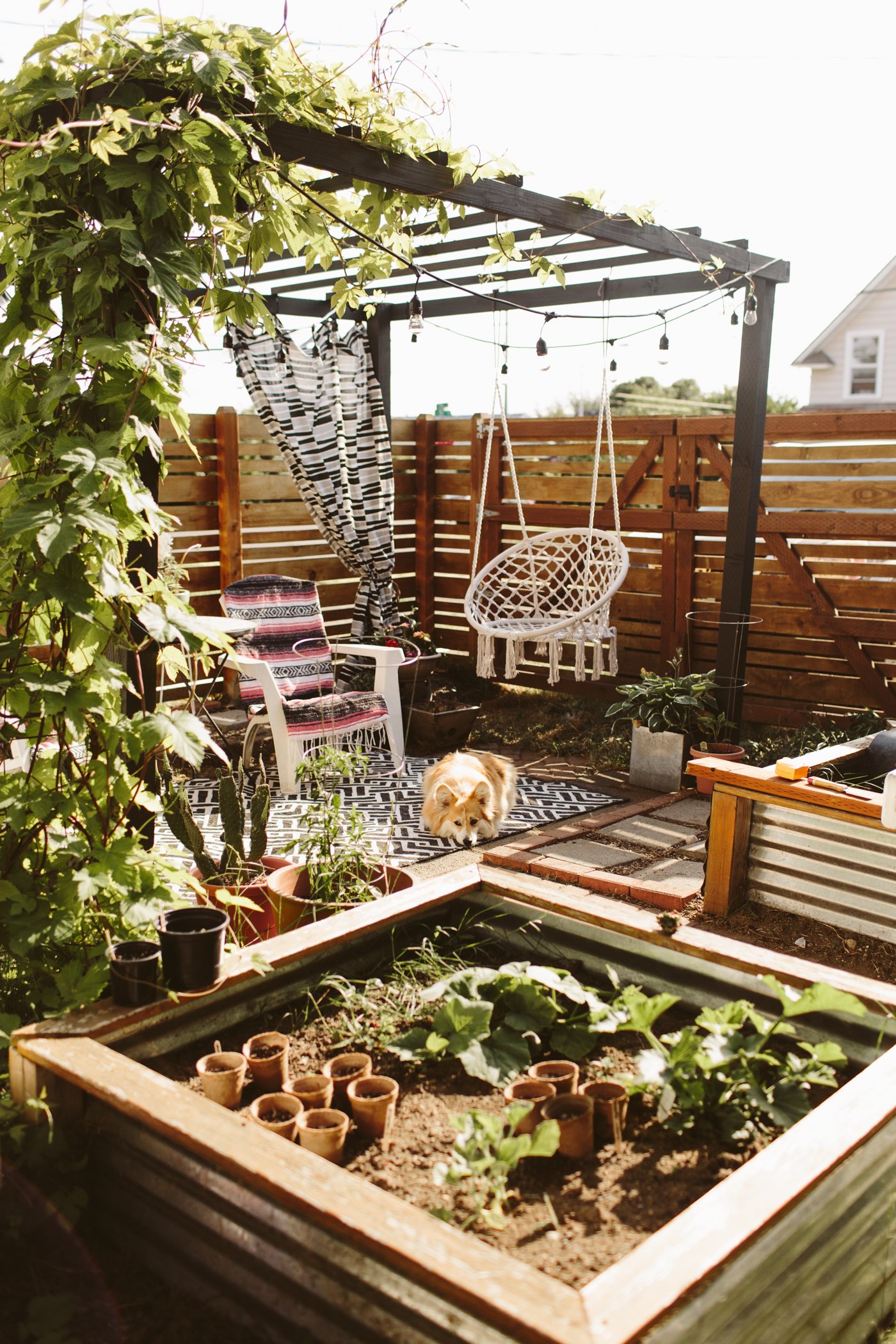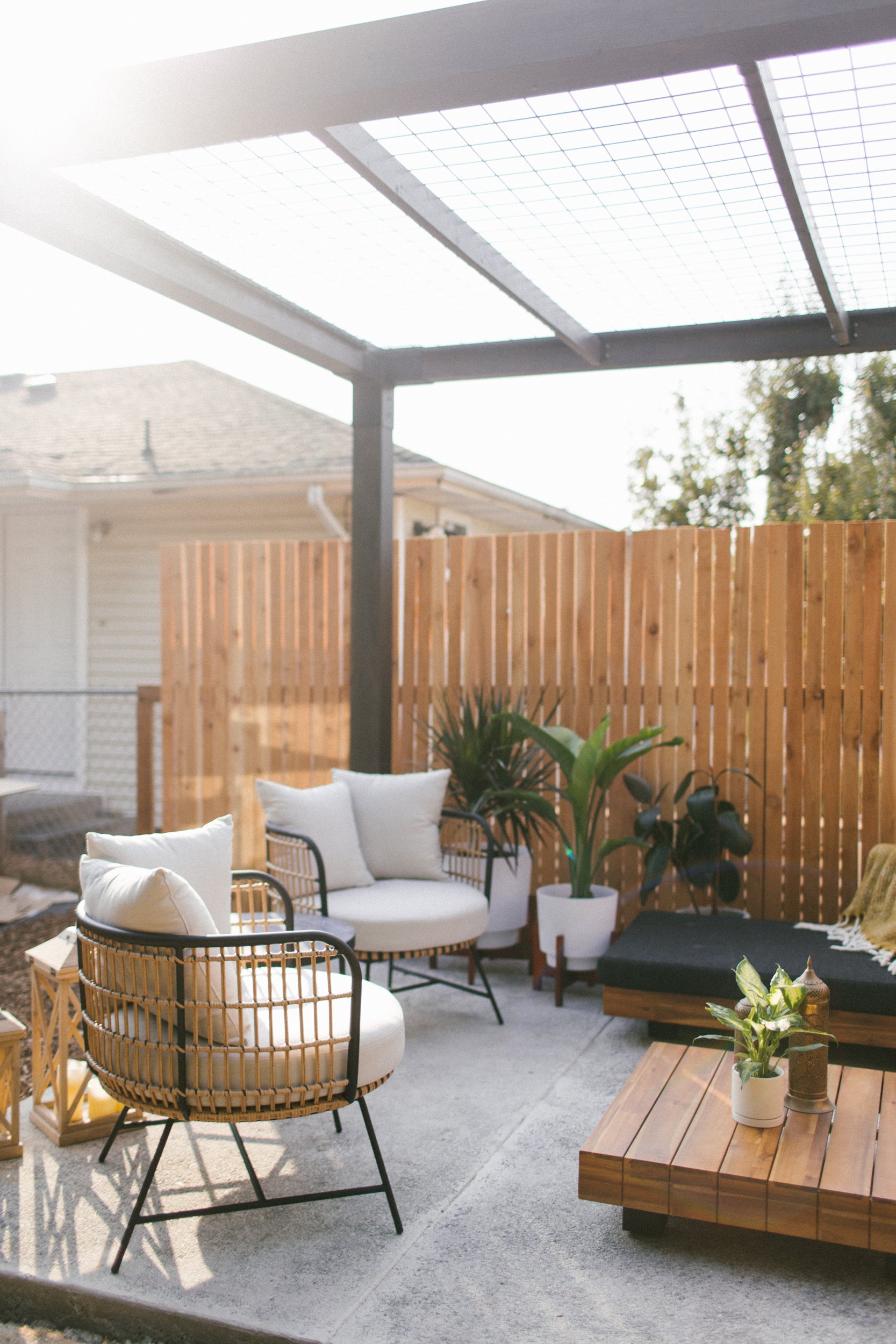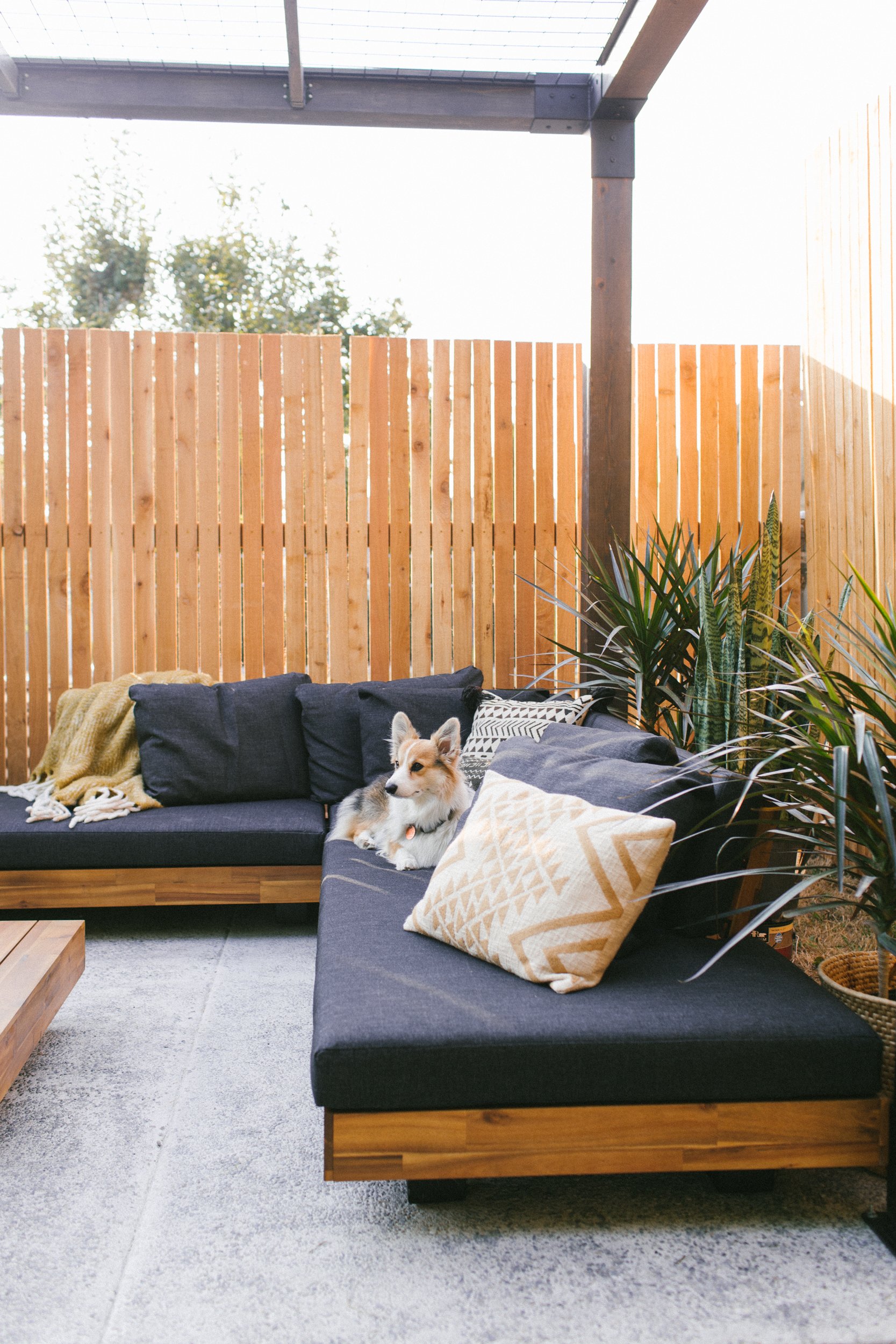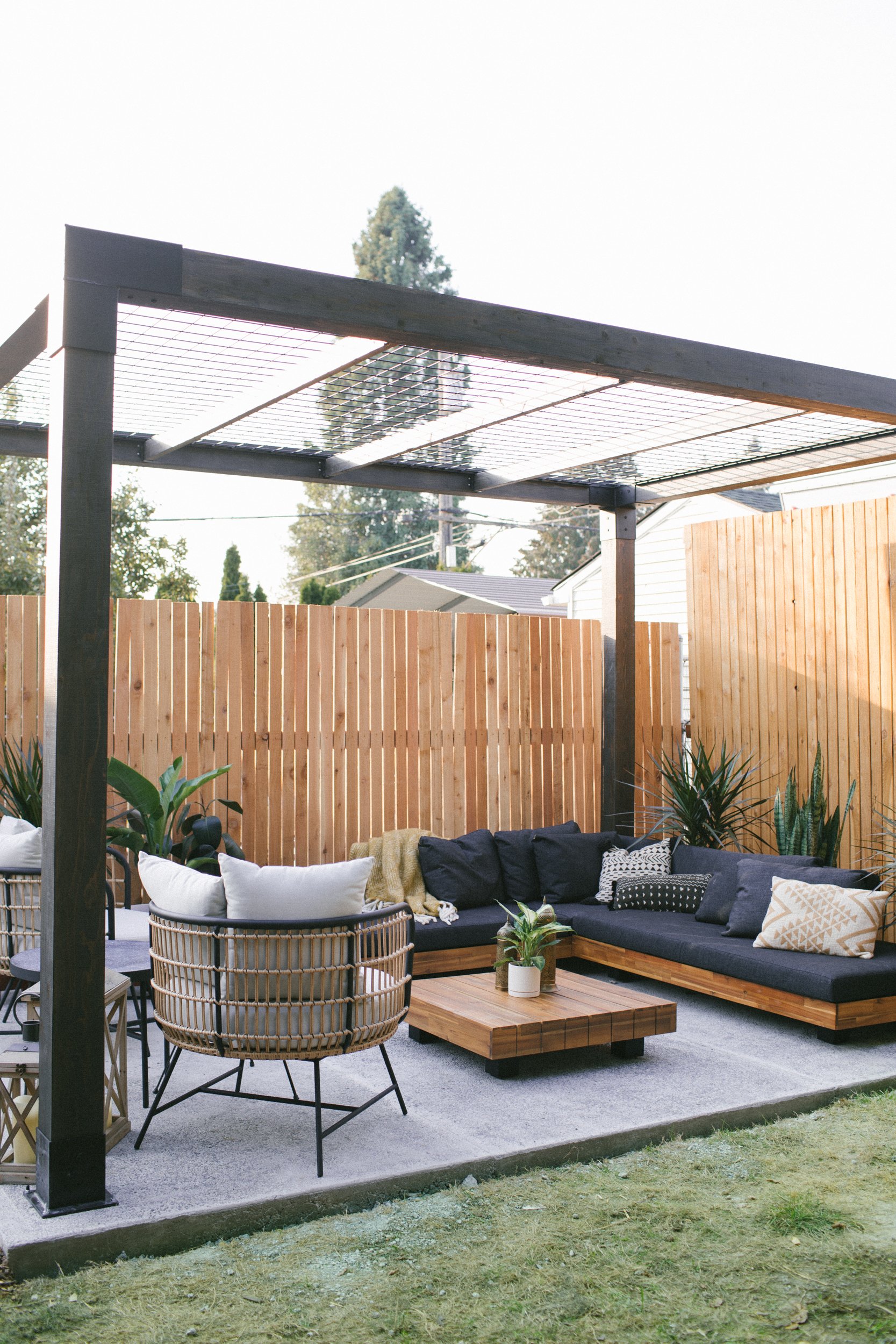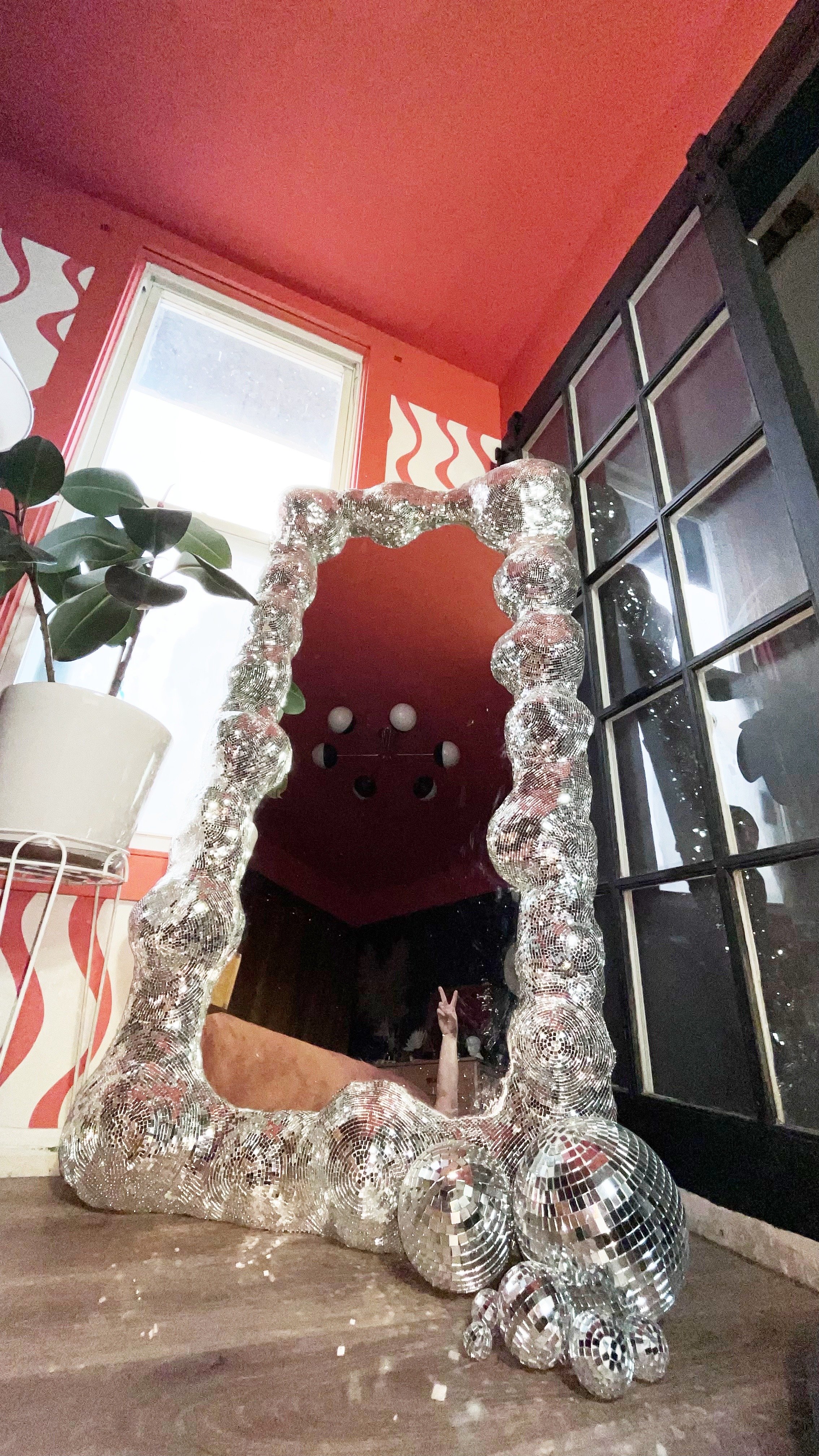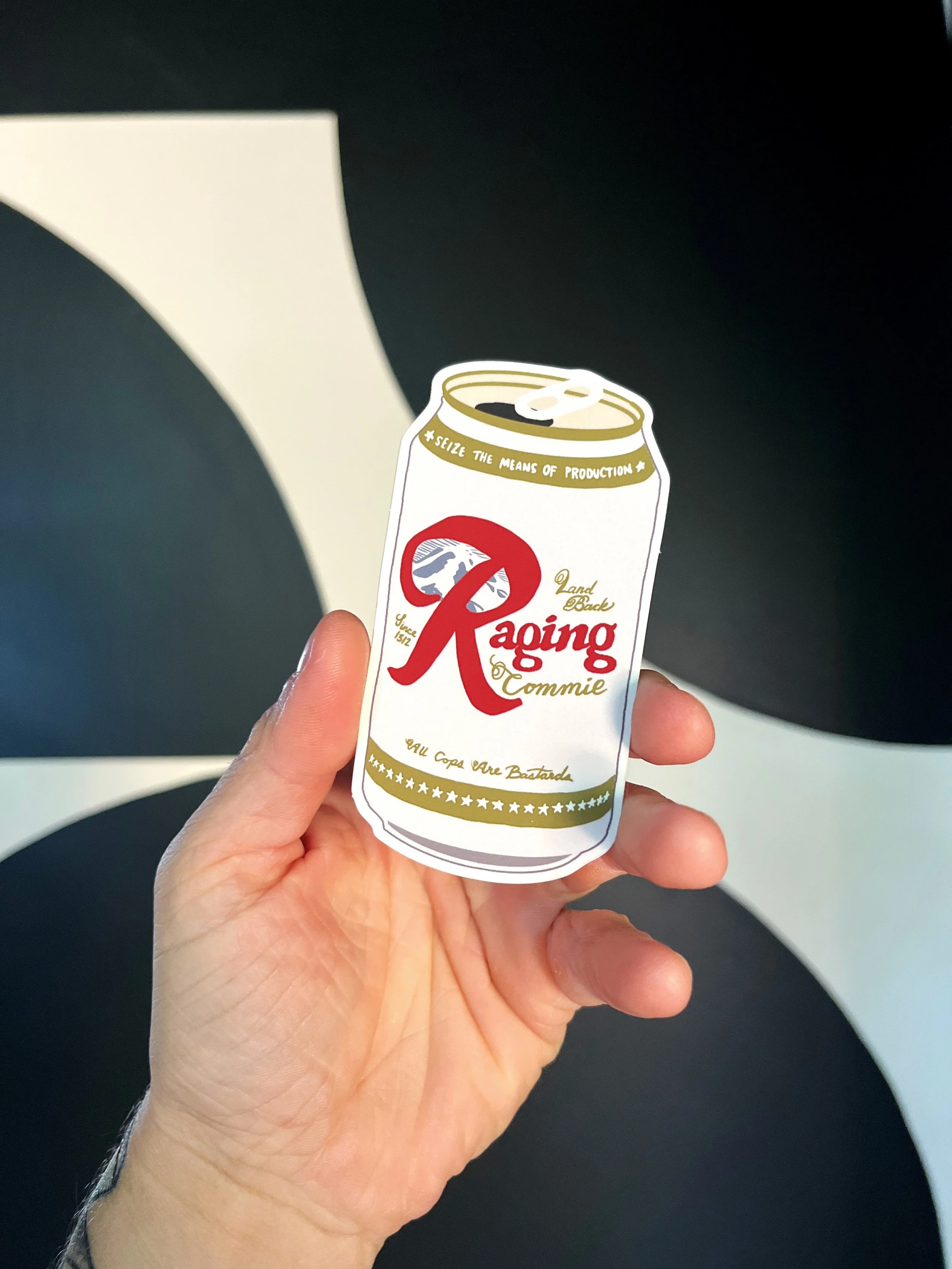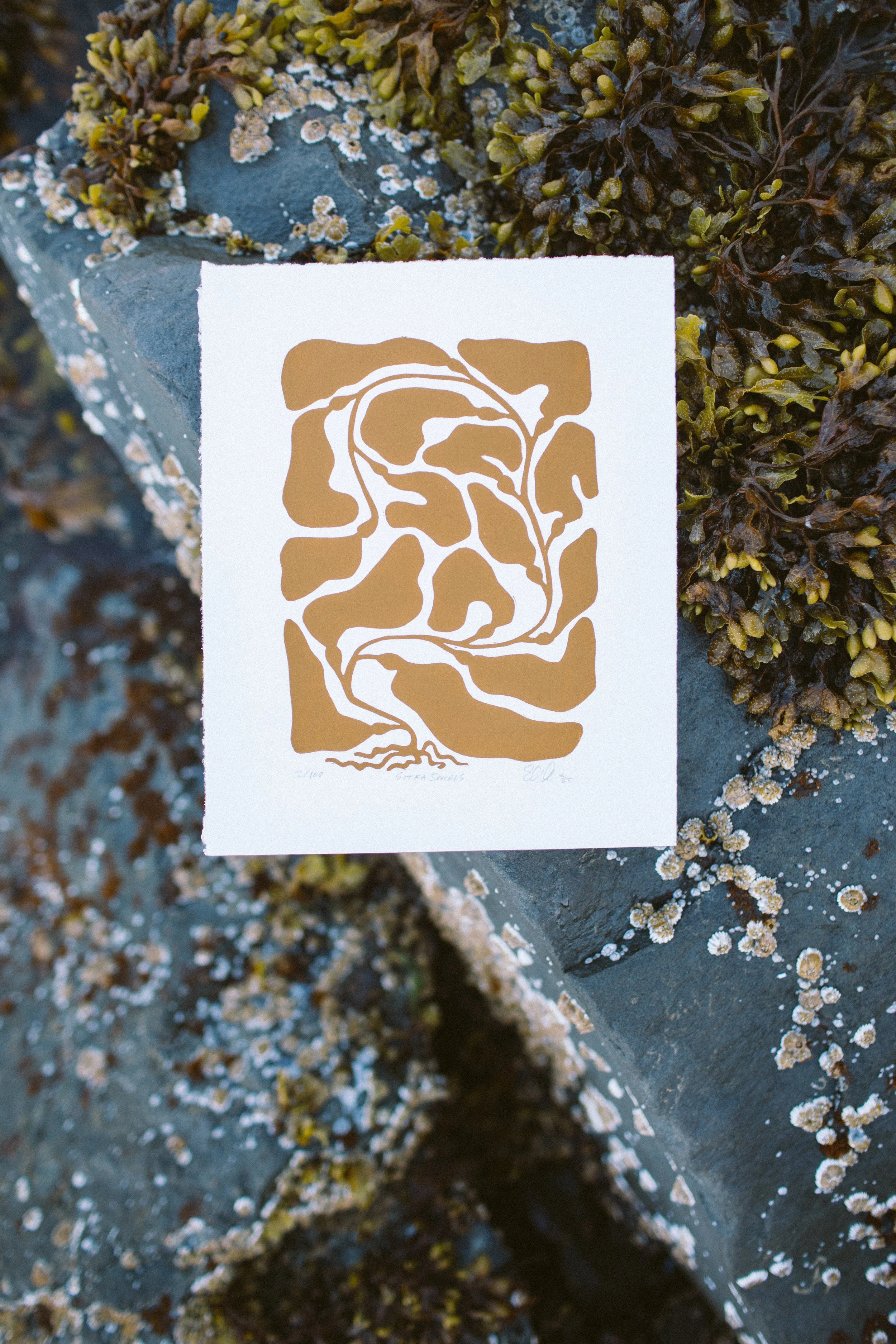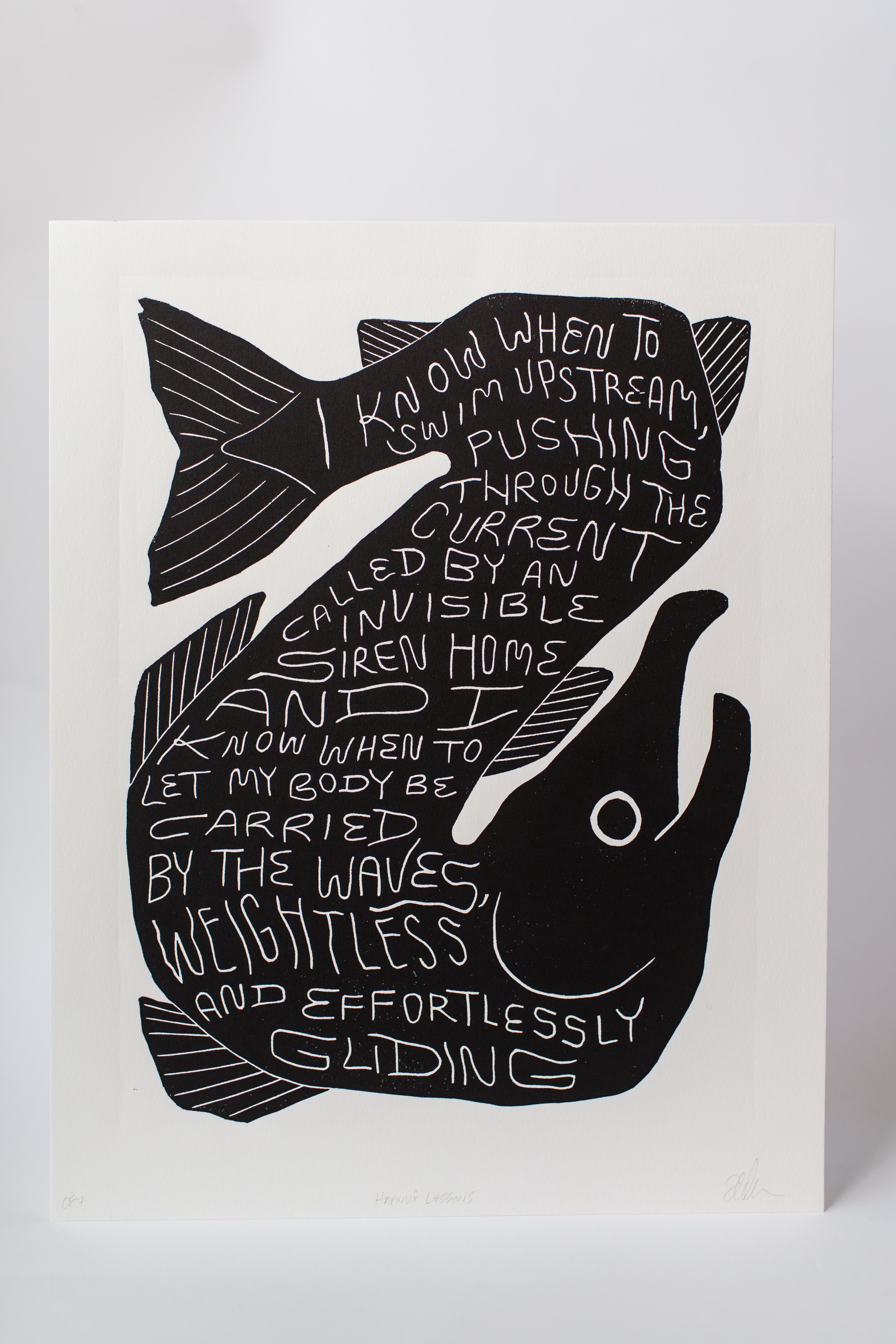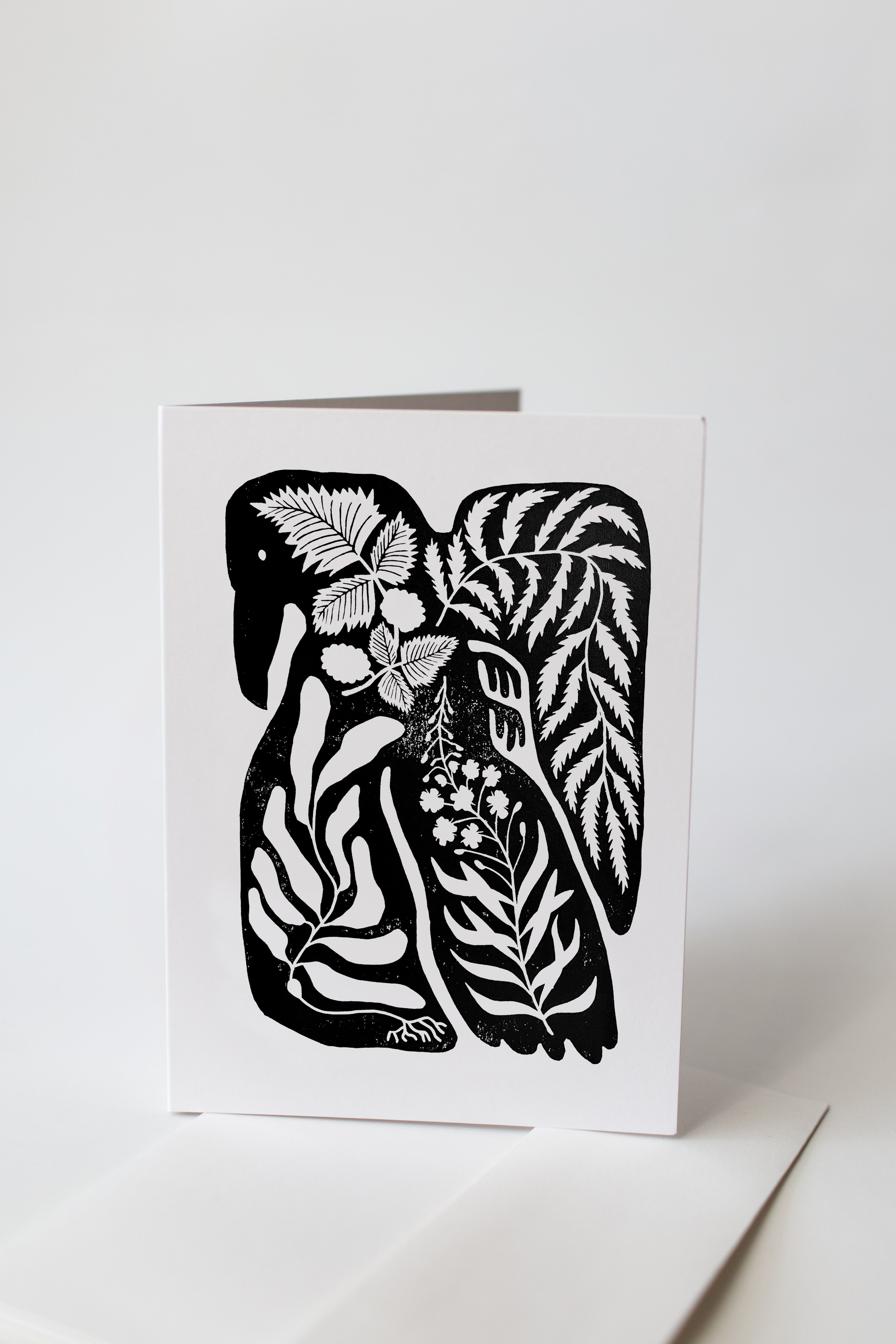New art acquisition: Racheal Jackson
If you call stuff you buy an “acquisition” it makes you sound very fancy and highfalutin. I’m an art collector, folks.
I want to introduce you to one of my favorite people: Racheal Jackson. You might know her better as @banyanbridges on Instagram or from her hit Magnolia show Artfully Designed. She’s renowned for her bright, colorful, and playful murals. She has the best vibes, both online and offline, and watching her flourish as an artist has been such a wonderful thing to witness.
When Racheal announced that she was selling these big cut-out sculptural squiggles, it was just before my birthday and I decided to give myself a squiggle. I knew exactly where it needed to go. I absolutely love this slat wall that divides my studio space from our living room— it defines each space while still letting light through in both directions. I’ve always wanted art on this slat wall, but I also didn’t want something like a canvas or framed art that not only would block the light, but you would also see the “ugly side” of the art when looking at the slat wall from the studio side. This piece has no such issues! And oh my god do I love it so much.
Knowing Racheal, it’s fun to look up and see a bit of my friend living here in my house. She actually bought one of my Home Sweet Tacoma steamroller prints so we’ve now swapped art and both have each other’s work hanging in our homes, which I love. It’s always a funny phenomenon, one I notice often at art markets and craft fairs, that the artists and makers themselves are the ones who find themselves shopping at the other vendors’ booths. It’s hard not to when there are such amazing folks around you making beautiful things.
support your artist friends,
diy globe hanging light


have a pretty big globe collection in my house and the one the started it all had broken off its brackets last year and looked a bit sad. I thought it could use some new life so I turned it into a pendant lamp! I get all my globes from thrift stores and pretty much every time I see one I get it. Almost every room in our house has a little collection of globes now.
My studio space is one of the few rooms in the house that I haven't really started working on. It's sort of the catch-all because nobody ever sees it. You have to go though our bedroom, upstairs, through our closet and then to the studio, so it's mainly just a place where I throw stuff to "organize later" (read: never). What you don't see in these photos is the giant pile of mess just out of frame, but I promise it's there and it's scary. I need to rip the ugly brown carpet out of the entire upstairs, so part of me doesn't want to bother cleaning it up because I'll have to take everything out of there to remove the carpet and put in new flooring anyway. You can kind of see the carpet around the edges of the zig-zag rug. It's bad. I actually realized that I ripped the exact same carpet out of the Brave when I re-did her floors in May. The Brave looks so much fancier without that old brown carpet (it wasn't even the original green carpet, bleh), so I can't wait to get new floors in this attic space.
When we looked at this house before buying it, I was entranced by this upstairs space. I immediately claimed it as my studio. I recently looked at a few homes for sale with my parents and in every single one I was enamored with the very top floor with slanted ceilings. Maybe it reminds me of a treehouse or something, being on the very top floor, but I love me some attic spaces. I'd love to put a dormer in to expand the space and bring in more light. The room is pretty dark with just the one window on the end, especially in the winter, so it'd be nice to get a little more space and natural light.


What You'll Need:
rotary tool with cutting bit and/or utility knife
drill (or rotary tool w/ drill bit)
hanging light cord (Ikea has the Hemma cord or here's one on Amazon.)
light bulb
safety glasses
First, remove the globe from its stand. Depending on the kind of globe you have it might be a bit difficult, mine was kind of a pain.
Since your globe has latitude lines on it, you can use that as a line to follow when cutting your hole in the bottom. I used 45º S for mine, but you can pick any, depending on how large you want the opening to be.
Using your rotary tool with a cutting wheel bit, or just using an x-acto knife, cut along the line to make the hole in the bottom of your light. Make sure you use goggles if you're using a dremel because it'll fling particles up at your face. I did most of mine with a rotary tool and then used an x-acto to cut any pieces that were left holding the bottom on.



Take your lamp cord and put it at the north pole where it'll hang from and trace the circumference. Cut your hole along this line.

If you'd like light to show through little holes on in the side of the globe, use a drill or your rotary tool with a drill bit and drill little holes! I drilled holes along the edges of the continents for mine. A fun version of this lamp could be painting the globe black and then drilling star constellations in the sides!
Once your holes are all drilled, unscrew the piece from the light cord that secures the shade and then push the threaded end of the cord through the hole you made at the top of the globe. Screw that piece back on the threads from the inside of the globe to secure the globe shade to the cord.

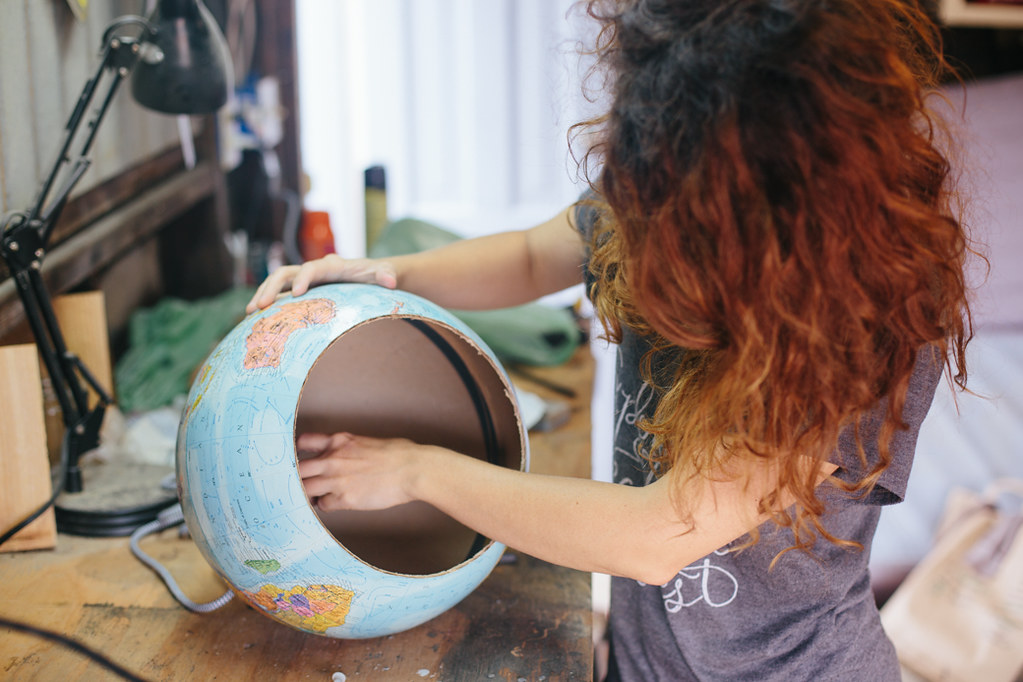

Plug her in and find a place to hang it! Hanging lamp cords usually comes with little hooks and cord holders to help hang it, but if you get another kind of cord, you'll need some hooks to hang it up. I love this light hanging above my studio desk, it gets to hang out with the other globes that have parked themselves on the desk.

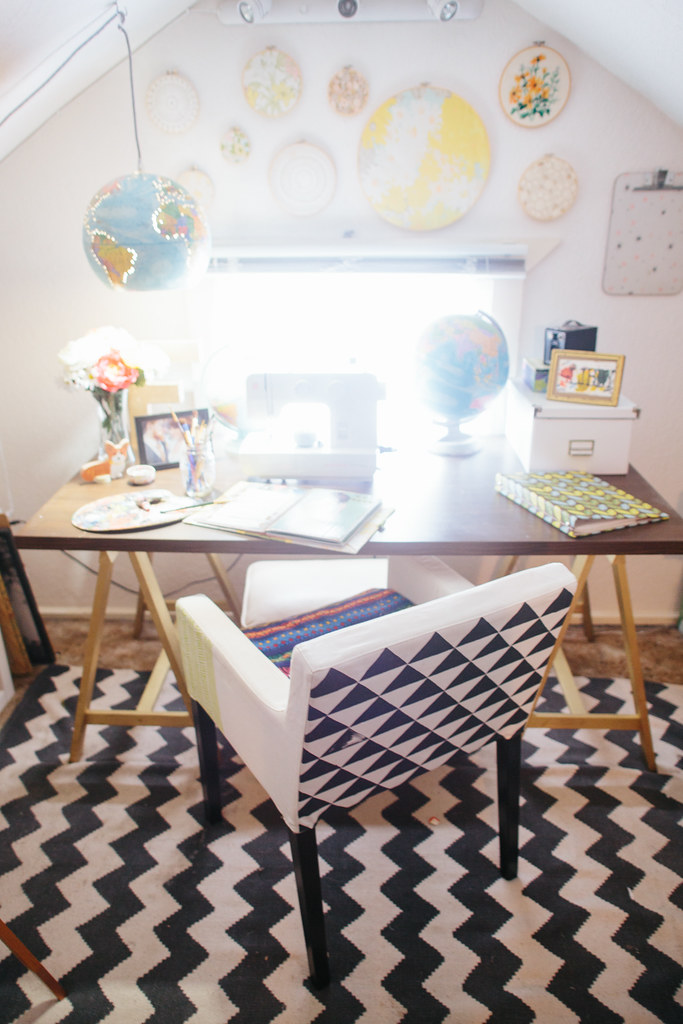
easy DIY macrame pot holders

his is actually a DIY I did last summer, but never ended up posting! I wanted to liven up my front porch, so I made these super easy hanging pot holders and planted some little marigolds. All you need is some rope and pots!
During Christmas I put faux Poinsettias in the pots, but I noticed that the red dye in the faux flowers bled all over the pots and rope. Luckily the dye washed away in the rain after a couple months, but if you live in a place that's rainy and want to put faux flowers in your pots outside, take note. Real Poinsettias are too large for these pots so I'll have to figure something else out next winter.
This is a really quick project, depending on how many you're making. I have six hanging from my front porch and it took me a couple afternoons, mostly because I ran out of rope and had to go buy more. I'd say each one only took 10-15 minutes.


You'll need six lengths of rope (or yarn, I made some hanging candles in mason jars using this same tutorial using yarn.). I'd recommend cutting the rope longer than you think you might need it, it's better to have extra than not enough. I used white rope and a simple terra cotta pot which I panted white with exterior paint (since my pots would be outside in the rainy northwest weather). The amount of rope you need will depend on how long you want your macrame holders to be. Mine hang about 3 feet down and I believe I made the ropes about 5 feet each.
Tie the ropes in a knot leaving a bit of extra (you can always cut it off later). Separate the three pairs of rope so they're easy to see. Tie the adjacent pairs together with a square knot. This will be the base of your pot holder, so where you tie them will depend on how big the base of your pot is. Try to aim for tying this first knot at the length of the radius of the base, or a bit longer. Go around and tie all three pairs.



Now that all three are tied together, separate the free ends. Tie these new adjacent strings together for your "level 2" knots. Make sure all your knots are the same distances, so each level is at the same point, otherwise it'll get lopsided. If you're not sure if your knots are in the right place to create the right size space for your pot, have your pot on hand and you can slip it in there while you're making it to see if your knots are going to fit the pot. Knot each adjacent pair.
You can keep knotting as high as you like, but I found that three levels of knots works good for a small pot. Slip your pot in there to see how it fits and if it looks good, you're done! Knot the top of the strings so the pot hangs where you want and then screw a hook to the ceiling, or wherever you're hanging your pot from and hang it!




I was lazy with my pot holder and just let the ends fray, but if you wanted to make the ends cute you could leave them super long and put a wood bead on the end and knot it for a bit of embellishment. Or you could singe the ends of the rope/string so that they didn't fray.

Budget vs Investment Pergola Comparison
Are you considering adding a pergola to your outdoor space but unsure whether to opt for a budget-friendly option or invest in higher-quality materials and expert craftsmanship? When it comes to outdoor structures like pergolas, it's important to weigh the benefits and drawbacks of both options. While a budget-friendly option may seem attractive upfront, investing in a high-quality pergola can provide long-term benefits such as increased durability, better resistance to outdoor elements, and a longer lifespan overall. To help you make an informed decision, we've put together a comparison of two different pergola projects: one completed on a budget using lower-quality materials, and one that utilized high-end materials and expert craftsmanship.
Let’s start with the budget pergola.
Several years ago I spotted a modern black pergola at Target. It was metal, and had a really simple silhouette that I loved. I believe it was around $400-500, which at the time was out of my budget (they no longer sell that one, but this one is similar). So one weekend I decided to build one myself that had a similar feel to it, and I did it for around $100. You can see that project here.
It actually ended up being a pretty great dupe of the Target version, and I made it using 4x4, 2x4, and 2x2 lumber, painted black. It was the perfect little pergola for our hops to climb on and I believe we had this pergola for about 3 years before we sold the house.
Pros:
— It was super affordable. I used cheap pine (instead of outdoor treated lumber or cedar), and paint I already had on hand.
— It was the perfect place for our hops to climb, which made perfect shade in the summertime.
— It had the style I was wanting.
— It was easy and quick to build.
Cons:
— After a while it wasn’t very sturdy. I didn’t anchor it to the ground because it was sitting on concrete (and because I didn’t want it permanent), and it didn’t have any angle bracing in the corners. After a couple years we added some angle bracing in the corners to shore it up.
— Because it wasn’t made with outdoor lumber it might not have lasted for many years due to rot (especially because of how wet the winters are here in the pnw).
Despite the cons, I really liked this pergola. It was extremely affordable to build, and brought us tons of enjoyment for the few years we had it. We didn’t have the budget for something more expensive, so rather than not having a pergola at all, we had one that was a little chintzy, quality-wise, but it was all we needed. Had we stayed at this house for longer, I probably would have eventually replaced it or rebuilt it to something more high quality that would last a long time. (Also, it should be noted that this was built prior to the price hikes on lumber in 2020, so it might be over $100 to build at this time).
The investment pergola:
This pergola was part of an entire patio build project, so I knew I wanted something that was high quality, sturdy, and would last. Because the budget pergola was built in front of our garage door, I didn’t want it to be permanent in case we ever needed to drive a car into the garage (we didn’t use it for a car, but just in case). This pergola wasn’t going to be going anywhere that it might need to move, so I felt comfortable installing something super permanent.
This pergola, with all the components we used, totals about $3500. Because I worked with LINX on this project as a sponsored campaign they provided the materials, so I made sure to price things out online so I could know the full cost of this pergola. This number includes all the brackets (the corner brackets, and the base brackets that attach it to the patio), the metal grate on the roof, and the 6x6 timbers. LINX makes their own hollow engineered timbers, which I used in this pergola (they’re nice because they are lighter weight and you can hide any electrical cords inside the hollow core if you’re doing any sort of lighting). These timbers are definitely more expensive than standard 6x6 lumber, so you could also cut costs there as well.
Pros:
— This thing is solid. It’s definitely going to last decades.
— It has the style I want (again— modern), but there are also a ton of different ways to utilize the LINX bracket system to create a totally custom pergola.
— Even though the timbers are engineered, they’re still real wood (unlike something like Trex decking, which isn’t) so I could stain them the color I wanted.
— I designed the custom roof to be the perfect place for hops to climb because I loved how the hops climbed on our old pergola so much (LINX also has shade sails that work perfectly with their brackets, if you’re wanting a shade situation)
Cons:
— Way more expensive than $100 (we built ours with 6x6 lumber/brackets, which are more expensive. LINX also has 4x4 brackets and STIX timbers that cost a bit less).
— Not as easy or quick to build. Because this was made with 6x6 timbers, it was much heavier, and we needed about 4 people to put it up, whereas I was able to build and put up the cheaper pergola entirely by myself.
I love both of these pergolas for different reasons, and I don’t think one is better than the other because each one has their place. Not everything has to always be the highest, best quality. It’s okay to do things in a more affordable way, especially if you go into it knowing that it’s not going to last forever. Our cheap pergola worked amazing for us, and the fancier LINX pergola is perfect in its own way as well. Most importantly, do what works for your life, your space, and your finances.
Now, obviously, there’s a pretty big gap between $100 and $3500 and there are plenty of pergola options out there in between that price range.
10x12ft Pergola — $1422
12x12ft Pergola — $599
10x12 ft Pergola — $2048
10x12 ft Pergola — $1633
10x12ft Pergola — $630
I hope that gives you a few more options within some different budgets for pergolas. I haven’t used any of the ones I linked above so I can’t speak to their quality, but they all have a similar modern look, which is what I was going for with both of my pergolas. I can’t wait to get outside this summer and enjoy our new patio and pergola, and I hope this helps you figure out your pergola patio situation this summer too!
The DIY Disco Mirror
This is what happens when you buy a mirror off of craigslist to customize, with no real plan, and then go completely off the rails. I had a few different concepts when I was trying to decide what I wanted to do with the mirror and of course landed on the most time consuming and expensive option: melty disco ball frame.
What I used:
Disco Mirrors (I used appx 40,000 mirrors)
GemTac Glue (I used appx 2 4ox bottles)
Spray Foam (I believe I went through five 12oz bottles)
Joint Compound
Cheesecloth
I explain the process in the above videos, but basically: the base shapes are made out of spray foam, then joint compound to fill in any gaps and smooth the surface. I sanded to smooth the bumps, then primed, and from there on out it was just a never ending process of sticking mirrors on. I bought 5mm mirrors, which were smaller than I’d anticipated, so if I was doing this over again I’d probably get 10mm mirrors. I do love the density of the 5mm mirrors, but it took forever to put that many mirrors on.
The mirrrors I used had adhesive backing, but I didn’t trust that adhesive to stick well enough, especially with the undulating shapes I was applying them to (they felt strong enough to apply to smooth, flat surfaces), so I used GemTac glue to apply each one. In the larger areas I could apply strips of 4 or 5 mirrors at a time, but in the tighter curves I definitely needed to apply them one by one.
Hi, I’m Liz
I'm an artist, writer, designer, DIY renovator, and … well basically I like to do all the things. If it’s creative I’m probably doing it. I’ve spent over 30 years voraciously pursuing a life steeped in creativity and I wholeheartedly believe creativity and joy are inextricably linked.
Read more…
Explore The Archive
- July 2025
- May 2025
- January 2025
- December 2024
- August 2024
- July 2024
- May 2024
- April 2024
- January 2024
- December 2023
- October 2023
- September 2023
- July 2023
- June 2023
- May 2023
- April 2023
- March 2023
- February 2023
- January 2023
- December 2022
- November 2022
- October 2022
- August 2022
- June 2022
- May 2022
- April 2022
- March 2022
- November 2021
- October 2021
- August 2021
- July 2021
- May 2021
- January 2021
- November 2020
- October 2020
- September 2020
- August 2020
- July 2020
- June 2020
- May 2020
- April 2020
- February 2020
- January 2020
- November 2019
- October 2019
- August 2019
- July 2019
- June 2019
- May 2019
- April 2019
- February 2019
- January 2019
- December 2018
- November 2018
- October 2018
- September 2018
- August 2018
- July 2018
- June 2018
- May 2018
- April 2018
- February 2018
- January 2018
- November 2017
- September 2017
- August 2017
- July 2017
- June 2017
- May 2017
- April 2017
- March 2017
- February 2017
- January 2017
- December 2016
- November 2016
- October 2016
- September 2016
- August 2016
- June 2016
- May 2016
- April 2016
- March 2016
- February 2016
- January 2016
- December 2015
- November 2015
- October 2015
- September 2015
- August 2015
- July 2015
- June 2015
- May 2015
- April 2015
- March 2015
- February 2015
- January 2015
- December 2014
- November 2014
- October 2014
- September 2014
- August 2014
- July 2014
- June 2014
- May 2014
- April 2014
- March 2014
- February 2014
- January 2014
- December 2013
- November 2013
- October 2013
- September 2013
- August 2013
- July 2013
- June 2013
- May 2013
- April 2013
- March 2013
- February 2013
- January 2013
- December 2012
- November 2012
- October 2012
- September 2012
- August 2012
- July 2012
- June 2012
- May 2012
- April 2012
- March 2012
- February 2012
- January 2012
- December 2011
- November 2011
- October 2011
- September 2011
- August 2011
- July 2011
- June 2011
- May 2011
- April 2011
- March 2011
- February 2011
- January 2011
- December 2010
- November 2010
- October 2010
- September 2010
- August 2010
- July 2010
- June 2010
- May 2010
- April 2010
- March 2010
- February 2010
- January 2010
- December 2009
- November 2009
- October 2009
- September 2009
- August 2009
- July 2009
- June 2009
- May 2009
- April 2009
- March 2009
- February 2009
- January 2009
- December 2008
- November 2008
- October 2008
- September 2008
- August 2008
- July 2008
VISIT THE SHOP
PRIVACY POLICY & DISCLOSURE
We are a participant in the Amazon Services LLC Associates Program, an affiliate advertising program designed to provide a means for us to earn fees by linking to Amazon.com and affiliated sites.

